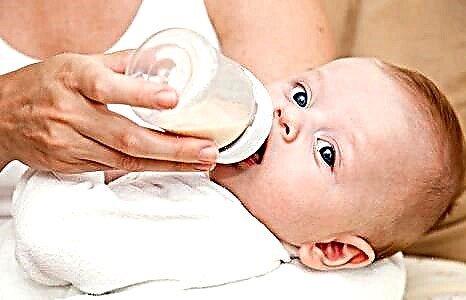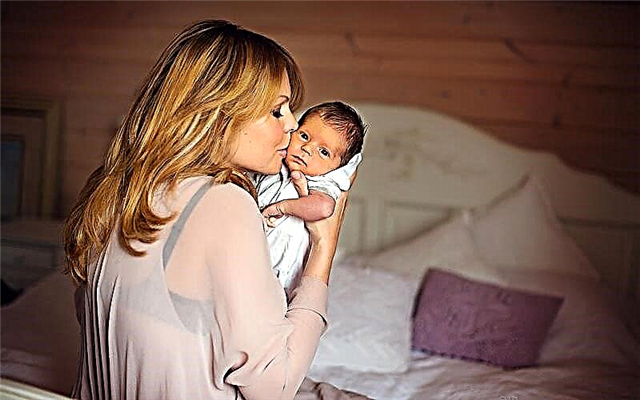All young mothers are well aware that in the first months of life there is no healthier nutrition than breast milk for a newborn baby. But sometimes a situation arises in which there is a need to transfer the child to another diet (there is no breast milk or the mother cannot breastfeed). Artificial feeding of a newborn baby requires the correct approach to both the choice of formula and to following a new diet. A consultation with a pediatrician is a prerequisite before starting IV.

Indications for switching to IV
Feeding even with the highest quality mixtures will not be able to replenish those trace elements that the baby receives with the mother's milk. Therefore, the introduction of adapted nutrition should always be justified. Pediatricians identify several circumstances when artificial feeding is considered necessary:
- Difficult childbirth, after which the mother must recover her strength;
- Taking some groups of essential medicines by a woman;
- Mom's infectious diseases;
- Lack of milk in the glands of the breast or its insufficiency. Lack of milk is determined by control weighing of the baby after feeding;
- Impossibility of feeding the child due to temporary absence. This indication is justified when there are no conditions for storing expressed milk or the period of absence of the mother is calculated in weeks.
Lack of milk production must first be restored with drugs that enhance lactation. Artificial feeding of the child begins to be carried out only if these drugs do not bring the expected result. It is not necessary to completely inject the mixture at once, even a few grams of breast milk are beneficial for the baby's body and you cannot deprive him of this benefit.
Pros and cons of using artificial mixtures
 Not all young mothers seriously think about what awaits them and their baby when switching to the use of infant formula. Often, just because of her convenience, a woman deprives a child of the necessary trace elements for his immunity and general health. Before deciding to switch to IV with a mixture recommended by a pediatrician, you need to weigh all the advantages and disadvantages of the new diet. The obvious advantages of artificial feeding of a child include:
Not all young mothers seriously think about what awaits them and their baby when switching to the use of infant formula. Often, just because of her convenience, a woman deprives a child of the necessary trace elements for his immunity and general health. Before deciding to switch to IV with a mixture recommended by a pediatrician, you need to weigh all the advantages and disadvantages of the new diet. The obvious advantages of artificial feeding of a child include:
- Possibility of feeding the baby by other relatives. That is, mom can calmly leave for her business and not worry that the baby will cry from hunger;
- When feeding a baby from a bottle, mom always knows how much he eats at a time and, if there are problems with well-being, she immediately notices this by the amount of remaining food;
- The appearance of allergies is always associated with the type of mixture. In order to determine the allergen in a breastfed baby, a nursing mother has to completely revise her diet;
- The mixture takes longer to digest than milk, so the number of meals a baby will eat is reduced.
These are some of the benefits of formula feeding but there are much more cons:
- Artists are more likely to suffer from colds, allergies in subsequent years. This fact is explained by the lack of special enzymes in their bodies that a baby can only get from mom's milk;
- The use of bottles requires constant sterility. If cleanliness is not respected, then dyspeptic disorders may develop;
- Babies fed with formula often suffer from colic and periodic regurgitation - a poor-quality nipple contributes to swallowing air;
- When traveling with a child, you have to take a separate bag with the mixture, bottles, sterilizers, that is, excess luggage;
- Often you have to change several types of mixtures in order to find the most suitable one;
- Artificial feeding of a child also implies certain financial costs. A good mixture cannot be cheap, and as the child grows up, it is required more and more from time to time.
There are much more disadvantages from feeding with mixtures than advantages, and therefore it is worth first trying to restore hypolactation, and only then resorting to this at least.
How to choose a mixture
The selection of the mixture must be agreed with the pediatrician. The doctor knows the peculiarities of your child's health and will advise on the most gentle nutrition. It is necessary to independently show increased attention to the choice of mixtures and be sure to observe the following criteria:
- Shelf life - the most important condition for the absence of unwanted reactions. Choose those boxes where there is a margin of time of use for several months;
- The packaging must not be opened or deformed. The presence of dents, scratches indicates non-observance of the transportation conditions, and such a mixture may be damaged;
- Food is made by age category. A newborn child should not be given a mixture intended for older children, an unformed stomach and intestines can react with serious diseases;
- You need to accustom your baby to the introduction of hypoallergenic mixtures;
- If your child has certain health problems, the diet may contain supplements that can help improve organ function. The mixture may contain herbs to boost immunity, iron to treat anemia.
We read a detailed article: How and what mixture is better to choose >>>
How to prepare meals
When artificially feeding a baby, his well-being will directly depend on how you prepare the formula. The instruction must be read and it is imperative to follow its points.
- For dilution, it is best to use special bottled water; when boiling, some of the nutrients are lost. If water is taken from the tap, then boiling it is mandatory;
- The dosage must be fully observed. An excess of the amount of dry mix or a lack of water can lead to an oversaturation of the intestines with nutrients, and this is reflected by colic, dyspeptic disorders. The lack of a dry base leads to the fact that the baby is capricious, asks for a bottle at the wrong time;
- The mixture is diluted directly in a bottle, where water is pre-poured with a temperature not higher than 50 degrees. Higher temperatures destroy beneficial bacteria;
- After dilution, the mixture is shaken and monitored so that there are no lumps. Before feeding, check the temperature - it should not be higher than 37 degrees;
- The hole in the nipple should be such that the baby makes some effort to suck. The flowing out in a thin stream leads to a complete rejection of the breast and to the fact that the stomach begins to rapidly stretch.
[sc: rsa]
The mixture can be prepared in advance, but it should be stored in the refrigerator for no more than a day and heated in hot water.
Video instruction:
How to feed your baby properly
Infants who are formula-fed often weigh much more than their peers who consume their mother's milk. This is not as good as it sounds, and with increased obesity, a variety of health problems arise. To avoid this, you do not need to overfeed the baby, you must take into account how much he drinks and how long he can go without a bottle.
- The bottle is chosen when the baby is completely fed with mixtures or their amount reaches 2/3 of the total nutrition. The nipple must necessarily have a narrow opening, this will not allow the baby to wean from the breast (how to choose a bottle for feeding);
- A teaspoon is used when the child feeds mainly on the breast, and receives the missing amount of food in the form of mixtures;
- Sometimes the child refuses both the bottle and the spoon, but he needs to be fed. In this case, the diluted mixture is poured through a syringe without a needle in small doses.
Feeding technique
- The baby should be in an almost vertical position, this is convenient for sucking and does not allow choking.
- Make sure that the milk completely covers the nipple and that air collects at the bottom of the bottle. This will prevent air from entering the stomach.
- After feeding, the baby must be held in an upright position so that the trapped air comes out.
We read:How to bottle train your baby
Rules and Tips

If you feed your baby with formula, this does not mean that he needs to be left alone. The baby may choke on milk or lose the bottle. The emotional contact of the mother with the baby is also important, therefore, holding him in your arms, you can calmly observe the concentrated face of the crumbs and rest from household chores.
The nipple on the bottle needs to be changed periodically, it quickly becomes thinner, and the mixture is poured through the opening in a continuous stream. Always use the mixture after preparation or store it in the refrigerator. Leftover food is discarded immediately.
The "artificial" baby needs an earlier use of additional complementary foods, this will make up for the deficiency of the missing microelements.
How much formula should a baby eat:
A newborn baby in the first month of life eats from 700 to 800 ml of the adapted mixture for 8-10 times. For 2-3 months of life, the amount of the mixture grows to 900 ml. With the introduction of complementary foods, the volume of mixtures decreases.
How to correctly calculate the required volume:
It is believed that the child has enough food, which is 1/5 of his body weight per day. That is, if the baby weighs 4 kg, then he should drink 800 ml of milk per day. In the first days of life, the baby can drink 30-40 ml at a time, then up to 100 ml. In this regard, the frequency of feeding after the first month of life decreases. See material: how much milk (formula) a baby eats in the first month
Frequency of sterilization of the feeding bottle and teat:
During the first month of life, all bottles and teats should be sterilized after each feed. First, the remnants of the mixture are removed with warm water and a brush, then all devices are boiled for 10 minutes. It is best to purchase a special sterilizer, using it, you will always be sure that the dishes are clean.
After the first month of life, it is enough to rinse the nipple and bottle and rinse them with boiling water. But still, make sure that the bottles are thoroughly washed, special attention should be paid to the threads, hard-to-reach places where bacteria can multiply in a few hours.
Is it possible to store the prepared mixture:
The prepared mixture is stored at room temperature for no more than 2 hours, in the refrigerator for no more than 12 hours. The remaining remains of the mixture after feeding are poured out, the use of such milk after an hour can lead to poisoning.
Free IoT
The baby's need for food at different times of the day is not the same. But still, it is necessary to adhere to a certain schedule with a deviation of half an hour in one direction or another. So you will always know what time the baby usually eats and can guess the time of a visit to the clinic or for a walk. If the regimen is observed, the baby falls asleep easier and is less prone to excessive weight gain,
Situations in which it is necessary to replace the mixture:
- The mixture is not suitable, causes frequent regurgitation, diarrhea or constipation, allergic reactions;
- Reaching a certain age. There is no sense in giving a formula for newborns to a baby 6 months old;
- The need to use special medicinal food.
Artificial feeding problems:
Artificial feeding of a child is considered "metabolic stress" in medicine and therefore causes a wide variety of reactions. Allergies, stool problems, colic occur in the first days in most babies. Some of them get used to it, others have to change the mixture.



